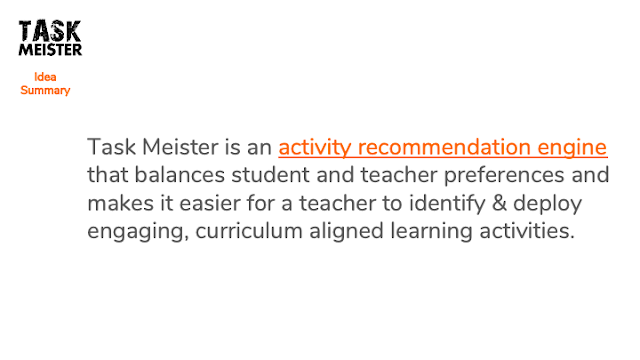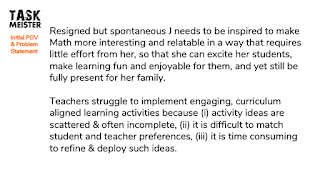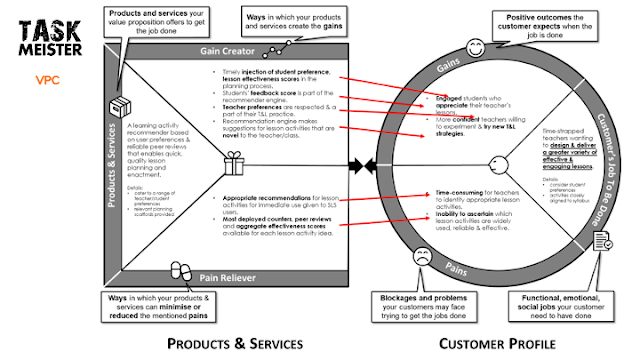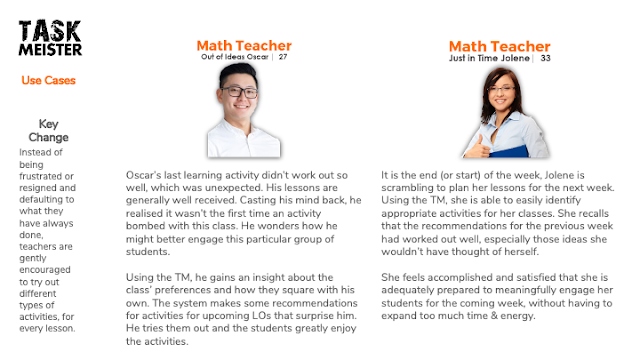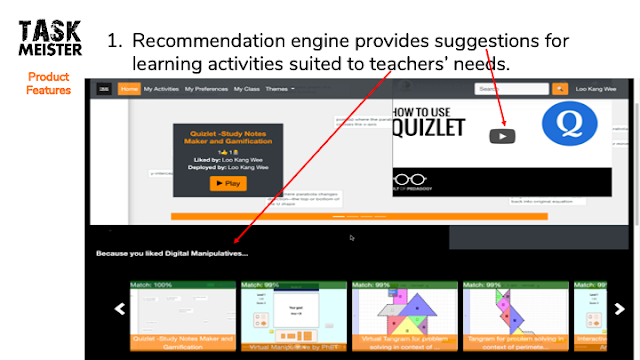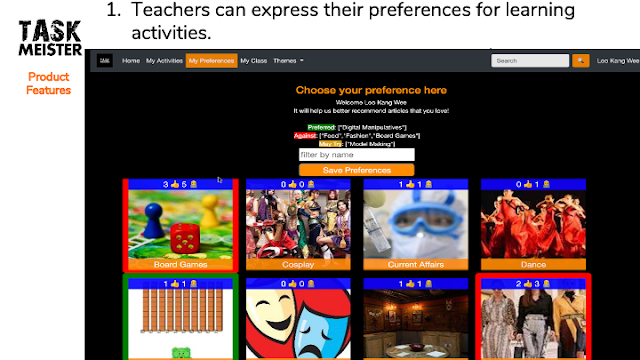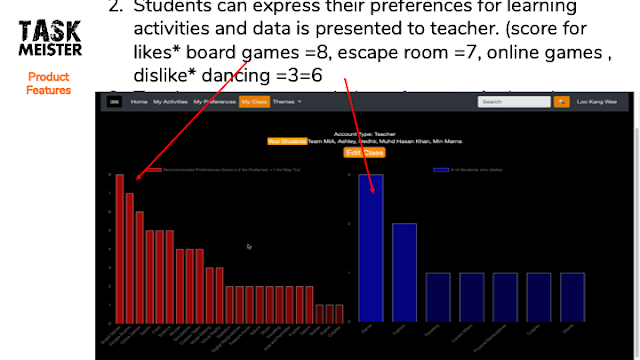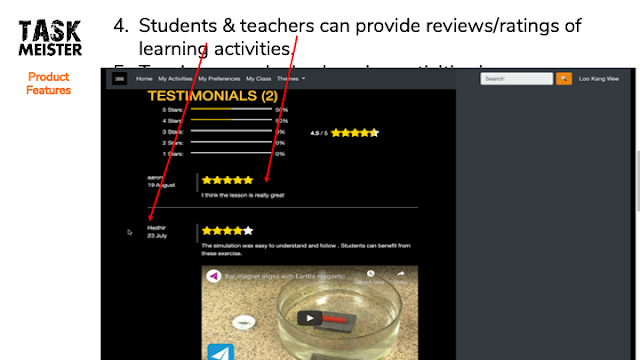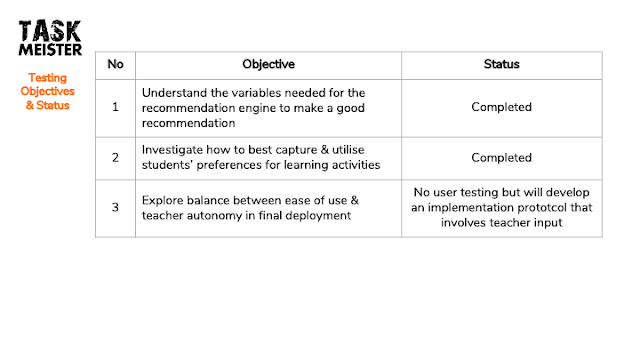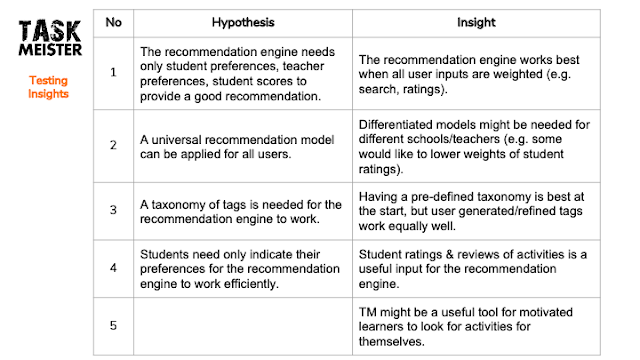https://docs.google.com/presentation/d/1VIxZRgSinyF-QChKfcH7os6hdUYnNIkiQXNhVQteb0w/edit#slide=id.p
1. Task Meister X: Classroom of the Future Prototype
- Core Concept: Task Meister X is identified as a "classroom of the future prototype" and a "recommender engine" created by Lawrence, Gerald, Fremont, and Chaiseng.
- Purpose: While the specific functionalities are not detailed on this overview page, the name "recommender engine" suggests it is designed to suggest or recommend learning tasks or resources to students.
- Target Audience: The breadcrumbs indicate its potential application across different education levels: "Primary," "Secondary," and "Junior College."
- Technical Basis:It has a dedicated URL: https://iwant2study.org/taskmeisterx/
- Its code repository is available on GitHub: https://github.com/FremontTeng/Task-Meister
- It has a stated "Pre-requisites: Joomla Content management system," indicating it likely integrates with or is built upon the Joomla platform.
- Context: The project falls under the "2019-20 COTF (Classroom of the Future) idea," suggesting it was part of an initiative exploring innovative approaches to education technology.
2. Open Educational Resources / Open Source Physics @ Singapore
- Central Theme: The website serves as a central hub for a vast collection of open educational resources (OER) and open-source physics materials developed and/or curated in Singapore.
- Focus Area: While the title highlights "Open Source Physics," the sheer volume and variety of resources listed demonstrate a broader scope encompassing mathematics, chemistry, biology, and even language learning.
- Resource Types: The list primarily consists of:
- HTML5 Applet JavaScript Simulations: This is the most prevalent type of resource, covering a wide range of scientific and mathematical concepts. Examples include:
- Physics: "SHM Bungee Displacement against Time Graph with Damping," "Swinging Magnet," "Kinetic Theory of Gases."
- Mathematics: "Circle Plus Question 05 HTML5 Applet Javascript," "Area of Trapezium (Proof using Parallelogram)."
- Chemistry: "SLS Bohr's Theory of the Hydrogen Atom JavaScript Simulation Applet HTML5," "Balancing Chemistry Equation JavaScript Simulation Applet HTML5."
- Biology: "Life cycle of Frog, Human, Chicken..."
- Interactive Games: Many resources are designed as interactive games for learning, often targeting specific concepts or skills. Examples include: "➕P3/4 Math Addition Game by Martin using Scratch," "Malay Shoot the Zombie Sentence Game Imbuhan."
- Tools and Editors: Resources like "EJSS Sim Web Editor by Raphael Yee" suggest the platform also supports the creation and modification of simulations.
- Links to External Resources: The inclusion of links to platforms like "cosci.tw," "trinket," "MolView," and "Easy Java/JavaScript Simulations Toolkit" indicates a collaborative and outward-looking approach to OER.
- Development and Contributions: The names associated with many of the resources (e.g., "by Boon Chien," "by Theresa," "by Luo Kangshun, Andy") suggest contributions from individual educators and potentially student projects (as indicated by the "SLS Hackathon" entries).
- Student Learning Space (SLS): The frequent mention of "SLS" (Student Learning Space) indicates a strong alignment with Singapore's national e-learning platform. Many resources are specifically designed for or integrated with SLS. Examples include "SLS Hackathon by Yumin Primary on Heat Gain by 3 Materials" and numerous resources prefixed with "SLS."
- Teacher Professional Development: The inclusion of entries like "20191029 -1111 Teacher Attachment 2019 ETDtogo: EdTech Takeaways" and "20190701-05 04 GIREP-ICPE-EPEC-MPTL Virtual Lab Learning Analytics-Moodle extension" suggest that the platform and its resources are also used for teacher training and professional development related to educational technology and OER.
- Recognition and Impact: The mention of being "Recommended in Journal Paper as One of the Top Three Websites for COVID-19 virtual labs education" and the "2020 Excellence in Physics Education Award from American Physical Society goes to Open Source Physics Team" highlights the recognition and impact of the work being done.
- Licensing: The website explicitly states, "Contents are licensed Creative Commons Attribution-Share Alike 4.0 Singapore License," emphasizing the open nature and reusability of the materials. It also provides specific licensing information for the "EasyJavaScriptSimulations Library" for commercial use.
- Community Engagement: The inclusion of "SLS Hackathon" events indicates efforts to foster a community around the creation and use of these open educational resources.
3. Key Themes and Important Ideas:
- Promotion of Open Educational Resources (OER): The website serves as a significant repository of freely accessible and reusable educational materials, particularly in STEM fields but extending beyond.
- Emphasis on Interactive Learning: The overwhelming prevalence of HTML5 applet simulations and games underscores a commitment to engaging and interactive pedagogical approaches.
- Integration with National Education Initiatives: The strong ties to Singapore's Student Learning Space (SLS) demonstrate an alignment with national educational technology strategies.
- Teacher as Creator and Curator: The numerous individual contributions and hackathon events highlight the role of educators in developing and sharing OER.
- Leveraging Open Source Tools: The use of JavaScript, HTML5, and platforms like Joomla and GitHub signifies a commitment to open-source technologies for creating and sharing educational resources.
- Innovation in Education Technology: Projects like Task Meister X exemplify the exploration of new technologies, such as recommender engines, to personalize and enhance learning experiences.
- Recognition of Excellence: The awards and journal recommendations point to the quality and impact of the OER developed and shared through this platform.
4. Conclusion:
The "Open Educational Resources / Open Source Physics @ Singapore" website, with its focus on Task Meister X, represents a significant initiative in promoting open access to high-quality educational resources. The sheer volume and diversity of interactive simulations, games, and tools demonstrate a vibrant community of educators dedicated to leveraging technology to enhance learning. The integration with the national SLS platform and the recognition received underscore the importance and impact of this work within the Singaporean educational landscape and beyond. Task Meister X, as a "classroom of the future" prototype, signifies an ongoing commitment to exploring innovative ways to utilize these open resources to personalize and improve the learning experience for students across different educational levels.
Task Meister X Study Guide
Quiz
Answer the following questions in 2-3 sentences each.
- What is Task Meister X and who are identified as its creators?
- According to the provided text, what is the primary purpose of Task Meister X?
- What are the listed prerequisites for using Task Meister X?
- Besides the main page, list at least two other types of resources linked within the document.
- Identify two subject areas, other than physics, for which interactive simulations or games are mentioned.
- What is the significance of the "SLS Hackathon" mentioned multiple times in the text?
- Name two awards or recognitions mentioned in the context of Open Educational Resources / Open Source Physics @ Singapore.
- What does the Creative Commons Attribution-Share Alike 4.0 Singapore License indicate about the content?
- Where can information about the commercial use of the EasyJavaScriptSimulations Library be found?
- What recent year is mentioned in relation to the "COTF classroom of the future idea on Task Meister X"?
Quiz Answer Key
- Task Meister X is described as a recommender engine and a prototype for a classroom of the future. Its creators are listed as Lawrence, Gerald, Fremont, and Chaiseng.
- Based on its context within "Open Educational Resources / Open Source Physics @ Singapore," the primary purpose of Task Meister X is likely to be an educational tool for students from primary to junior college levels.
- The listed prerequisite for using Task Meister X is the Joomla Content Management System, suggesting it is built upon or integrates with this platform.
- Besides the main page for Task Meister X, the document links to blog posts with additional information and pictures, as well as a GitHub repository for the project.
- The text mentions interactive content for Chemistry (e.g., "AST Chemistry Chapter Chemistry Learning Day") and Mathematics (e.g., "+P3/4 Math Addition Game by Martin using Scratch").
- The "SLS Hackathon" appears to be a series of events or initiatives focused on creating interactive educational resources, evidenced by the numerous examples of games and simulations developed under this banner by various schools and teams.
- The text mentions the "2020 Excellence in Physics Education Award from American Physical Society" awarded to the Open Source Physics Team, as well as "Gold Innergy Award 2019" and "Bronze Innergy Award 2019" submissions.
- The Creative Commons Attribution-Share Alike 4.0 Singapore License means that the content can be shared, adapted, and used for any purpose, even commercially, as long as attribution is given to the original source and any derivative works are shared under the same or a compatible license.
- Information about the commercial use of the EasyJavaScriptSimulations Library can be found by reading the license at https://www.um.es/fem/EjsWiki/Main/EJSLicense and by contacting This email address is being protected from spambots. You need JavaScript enabled to view it. directly.
- The "COTF classroom of the future idea on Task Meister X" is specifically dated as the "2019-20" idea.
Essay Format Questions
- Discuss the potential benefits and challenges of using a recommender engine like Task Meister X in a classroom setting, based on the information provided in the source.
- Analyze the significance of open educational resources (OER) and open-source physics initiatives, as exemplified by the content presented, for the future of education in Singapore.
- Based on the variety of interactive simulations and games listed, explore the pedagogical value of using such resources in teaching and learning across different subject areas and educational levels.
- Evaluate the role of events like the "SLS Hackathon" in fostering innovation and the development of educational technology within the Singaporean education system.
- Considering the licensing information provided (Creative Commons and the EjsWiki license), discuss the implications of different licensing models for the accessibility, use, and development of educational resources.
Glossary of Key Terms
- Open Educational Resources (OER): Teaching, learning, and research materials that are available freely and openly, permitting their re-use, re-purposing, adaptation, and redistribution by others.
- Open Source Physics: An initiative focused on creating and sharing freely available physics education resources, often including simulations and interactive tools, with modifiable source code.
- Recommender Engine: A type of information filtering system that predicts the rating or preference a user would give to an item, often used to suggest relevant content. In this context, likely suggesting educational resources to students.
- Joomla: A free and open-source content management system (CMS) used for publishing web content. It is mentioned as a prerequisite for Task Meister X.
- HTML5 Applet: A small application written using HTML5 (the latest evolution of the standard markup language for creating web pages) that can run within a web browser. These are often interactive simulations or games.
- JavaScript: A programming language commonly used in web development to add interactivity and dynamic effects to websites and web applications, including the mentioned applets.
- COTF (Classroom of the Future): An initiative or concept focused on exploring and implementing innovative technologies and pedagogical approaches to enhance the learning environment.
- SLS (Student Learning Space): Singapore's national online learning platform providing students with access to a variety of educational resources and tools.
- Hackathon: An event, typically lasting several hours or days, in which people collaborate to build software or hardware projects. In this context, focused on creating educational resources for SLS.
- Creative Commons Attribution-Share Alike 4.0 Singapore License: A public copyright license that allows for the free use and distribution of copyrighted material, provided that the original author is credited and any derivative works are shared under the same or a compatible license.
Other Resources
https://weelookang.blogspot.com/2020/10/cotf-classroom-of-future-ideatask.html
https://weelookang.blogspot.com/2020/08/pictures-for-task-meister.html
https://weelookang.blogspot.com/2020/07/task-meister-classroom-of-future-and.html
Task Meister X and Open Educational Resources in Singapore
Q1: What is Task Meister X and what is its purpose? Task Meister X is a prototype recommender engine designed for classroom use, particularly in primary, secondary, and junior college levels in Singapore. Its purpose is to recommend relevant learning resources and tasks to students. It was created by Lawrence, Gerald, Fremont, and Chaiseng as part of the "Classroom of the Future" initiative.
Q2: Is Task Meister X publicly accessible? Yes, Task Meister X has a public web interface accessible at https://iwant2study.org/taskmeisterx/. The underlying code is also available as open source on GitHub at https://github.com/FremontTeng/Task-Meister.
Q3: What are Open Educational Resources (OER) in the context of this project? In this context, OER refers to freely accessible and openly licensed educational materials, including interactive simulations, applets, games, and other resources. The "Open Educational Resources / Open Source Physics @ Singapore" platform hosts a wide variety of these materials, many of which are likely intended to be integrated with or recommended by Task Meister X.
Q4: What kind of learning resources are available on the "Open Educational Resources / Open Source Physics @ Singapore" platform? The platform offers a diverse collection of interactive resources covering various subjects, including physics, chemistry, mathematics, and even some language-based games. These resources range from physics simulations (e.g., mechanics, electromagnetism, waves) and chemistry models (e.g., molecular geometry, bonding) to math games (e.g., addition, geometry) and language learning tools. Many are built using HTML5 and JavaScript, making them accessible through web browsers.
Q5: Are these resources primarily focused on a specific educational level? While the Task Meister X project explicitly mentions primary, secondary, and junior college levels, the sheer variety of resources on the platform suggests a broader scope. There are materials suitable for primary school science and math, as well as more advanced physics and chemistry simulations relevant to higher levels of education.
Q6: What is the connection between the "SLS Hackathon" mentioned in the resources and the development of these educational tools? The numerous entries related to "SLS Hackathon" indicate a significant role in the creation and sharing of interactive learning resources. These hackathons, likely organized within the Singapore Student Learning Space (SLS) ecosystem, appear to be events where educators and developers create and prototype new interactive learning tools, many of which are then shared on platforms like the "Open Educational Resources / Open Source Physics @ Singapore" site.
Q7: Who are some of the key contributors or organizations involved in creating and sharing these OER? Several individuals and initiatives are mentioned, including Lawrence, Gerald, Fremont, and Chaiseng (creators of Task Meister X), Weelookang (who maintains a blog documenting the project), and the Open Source Physics team (which received an award from the American Physical Society). Additionally, various teachers and schools (e.g., Yumin Primary, Admiralty Primary, EJC) are credited for developing resources during SLS Hackathons. The Easy Java/JavaScript Simulations (Ejs) Toolkit by Francisco Esquembre and Félix Jesús Garcia Clemente is also a significant tool used in creating these simulations.
Q8: Are there any licensing considerations for using these Open Educational Resources? Yes, the website footer indicates that the contents are licensed under a Creative Commons Attribution-Share Alike 4.0 Singapore License. This generally allows for the free use, adaptation, and sharing of the materials, provided that attribution is given and any derivative works are shared under a similar license. For commercial use of the EasyJavaScriptSimulations Library, specific terms and contact information are provided
